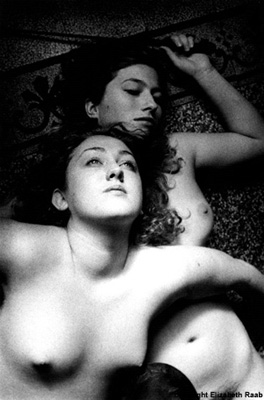Portraits in the Dark:
Selected
photographs
by Elizabeth Raab
from the Fur Caulis series.
November 2002

Zoe and Mercedes 2001
Fur Caulis 1999 - 2002
 |
 |
 |
 |
 |
 |
 |
Moments of Repose/Standing Tension
Excerpt of an interview of Elizabeth Raab by Michael Senno for
an
early showing of the Fur Caulis series. Rome, Italy December 2000.
What brought you and your work to Italy?
I originally came over here to travel after finishing high school in 1999. I came to stay with my cousins Yves Jaques and Sienna Ried, who offered me the very generous situation of living with them in exchange for some care for their son. I began language school shortly after that and found new influences that allowed me to begin new photographic work as well as a passion for the Italian life that led me to stay.
What specifically has Italy offered you by way of photography?
There is a passion for living that comes from being here. One is constantly surrounded by art, history and a close culture. Living with such talented artists and constantly being around creativity is very inspiring for ones work. The atmosphere here is not one to be found back in Seattle where things seem to move more quickly and with less care. There is a sense of never ending possibility and romance, and even sensuality that seems to permeate the air here in Italy. It is no wonder to me that I have found my experiences influential for my work in this environment. I have found some great contacts with collectives such as Camera O Scura as well as many outstanding individuals, something that has helped me and my work grow substantially over the past year and a half.
Your work in the
past has been very clear and paradoxically ambiguous, mainly in how you use
the dark shadows, the saturated blacks, where a figure may blend into the
background or a figure in the foreground may take up half the image and yet
it's just a cast of black without detail. You have used this style to some
extent in your new series, what are you working on with this?
I have in the past, as well with this series, used only available lighting
which, along with darkroom technique, helps define this particular style. The
drama this effect has on the scene, I believe, helps the viewer see in a more
dreamlike state which is important to me when viewing this type of artistry in
photography. The over saturation and almost ethereal quality these photos
carry help provide visual context for the story they tell. This story can vary
from series to series.
You've always
been working with ambiguous identity coupled with a paradox of uncertain
darkness and stark clarity however now that you are also using props
associated with vulnerability and bondage, what are you thinking of? What is
the story you are trying to portray with these images?
My images themselves are very similar to those in other series; they are dark
and mysterious and somewhat sexually charged. With this series however I am
bringing the sexuality more into the spotlight by the addition of the props. I
hope to engage the viewer with this by using the model, as I would in any
other shoot, as themselves in a somewhat natural state. By adding a
stereotypically sexual prop I am exploring what it is that turns an image into
a sexual icon. The part of the viewer is to decide weather it is the prop or
the person in the images themselves that make this photo a sexual image.
I see a sense of suspense and a sense of silence in your images.
I once read a book that used the sentence "The hill was large with silence." I
was always fascinated with that quote. The fact that an object or place could
be measured by silence fascinates me. I have tried to incorporate this feeling
into my work. I find it part of the aura of photography that captivates me. I
am allowed to study the world in a dreamlike state in these images regardless
of how the moment actually was in history. As Avadon said, “A photograph is
always accurate but never true.”
How do you
protect yourself from falling into the category of "sensational", regarding
your subject matter?
I don't. I do a type of work that could easily be seen as "sensational." There
is no doubt a shock value in my work. However this is due to a subject matter
that can frequently hardly avoid being so. I ask questions of the viewer that
I am presently asking myself. I consider a photo with a message and strong
content to be shocking to a viewer, as it should be. The value of art for me
is to ask questions, not only of myself and my own beliefs but of the world as
well.
Since this interview Elizabeth Raab has returned to the United States to Seattle, Washington to further continue her study of the photographic arts as well as continue her work on the Fur Caulis as well as other series.
To see more of the Fur Caulis series and other works by Elizabeth Raab please visit her web site at elizabethraab.com or contact her at elizabethraab@yahoo.com
